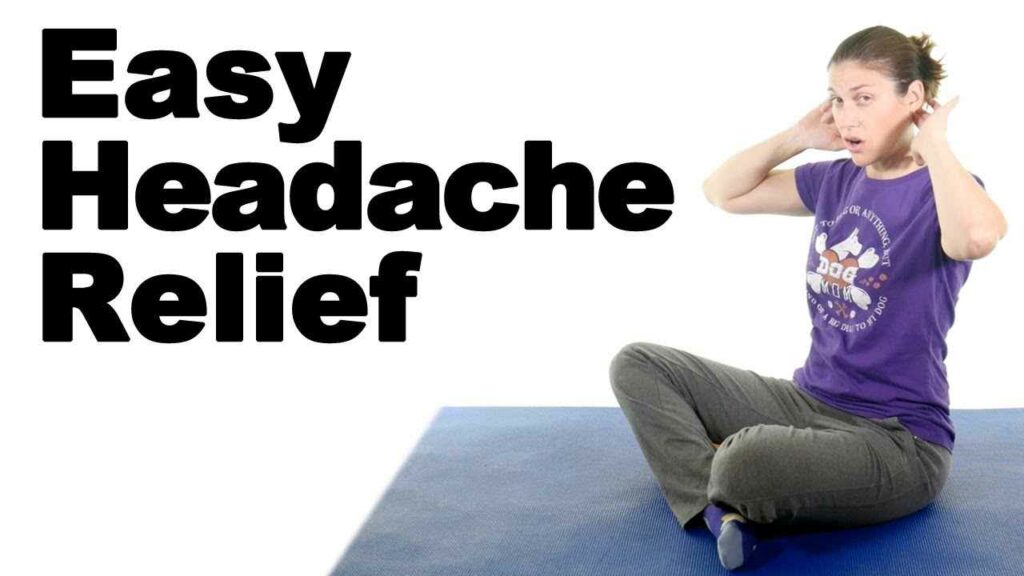Do you suffer from Cervicogenic headaches? If so, you know how painful and debilitating they can be. These headaches are caused by problems in the cervical spine, which can lead to pain and tension in the head and neck. Luckily, there are a few simple exercises that can help get rid of Cervicogenic headaches for good! In this blog post, we will discuss these exercises and how to perform them correctly.
Contents
- 1 What Is Cervicogenic Headache?
- 2 Symptoms Of Cervicogenic headache
- 3 Causes Of Cervicogenic headache
- 4 What Exercise Is Good For Cervicogenic Headache?
- 4.1 Cervical retraction
- 4.2 Cervical extension
- 4.3 Side bends
- 4.4 Shoulder shrugs
- 4.5 Side-lying neck rotation
- 4.6 Neck retraction
- 4.7 Doorframe stretch
- 4.8 Pectoralis minor release
- 4.9 Pec stretch
- 4.10 Suboccipital muscle release
- 4.11 Levator scapulae stretch
- 4.12 Posterior scalene stretch
- 4.13 Chin tuck exercise
- 5 What are the benefits of exercise in Cervicogenic headaches?
- 6 Conclusion
What Is Cervicogenic Headache?

A Cervicogenic headache is a type of headache that originates from the neck. It is often caused by muscle tension or arthritis in the neck. The pain from a Cervicogenic headache is usually felt on one side of the head and may also radiate to the temples, forehead, or back of the head.
Symptoms Of Cervicogenic headache
There are various symptoms of Cervicogenic headache. They are as follows:
- Dull, aching pain in the neck
- Pain that radiates from the neck to the back of the head or temples
- Stiffness and decreased range of motion in the neck
- Inflammation or tenderness in the neck muscles
- Trigger points in the neck muscles
These are symptoms that are commonly seen in people with Cervicogenic headaches.
Causes Of Cervicogenic headache
There are various causes of Cervicogenic headaches. They are as follows:
- poor posture
- injury to the neck or head
- whiplash
- degenerative changes in the spine
- disc herniation
So, these are causes of Cervicogenic headaches.
What Exercise Is Good For Cervicogenic Headache?

There are various exercises that are good for Cervicogenic headaches. They are as follows:
Cervical retraction
This is the first and foremost exercise that needs to be done for getting rid of cervicogenic headaches. In this, you need to sit in a comfortable position and then contract your neck muscles. You need to hold this contraction for about 5 seconds and then release it. Repeat this process 10 times a day for the best results.
Cervical extension
This is another great exercise for Cervicogenic headaches. In this, you need to sit in a comfortable position and then extend your neck muscles. You need to hold this extension for about 5 seconds and then release it. Repeat this process 10 times a day for the best results.
Side bends
This is yet another excellent exercise for Cervicogenic headaches. In this, you need to sit in a comfortable position and then bend your neck to one side. You need to hold this position for about 5 seconds and then release it. Repeat this process 10 times a day for the best results.
Shoulder shrugs
This is another fantastic exercise for Cervicogenic headaches. In this, you need to sit in a comfortable position and then shrug your shoulders. You need to hold this position for about 5 seconds and then release it. Repeat this process 10 times a day for the best results.
Side-lying neck rotation
Lie on your side with a pillow under your head. Gently turn your head to look over your shoulder, then return to the starting position. Do 2-3 sets of 10 repetitions on each side. For instance, if you rotate your head to the right, then your left ear should end up close to or touch the pillow.
Neck retraction
Start by sitting up tall with your shoulders down and back. Gently bring your chin toward your chest, then return to the starting position. Do 2-3 sets of 10 repetitions. For instance, if you have a headache that is caused by tension in the muscles of your neck and shoulders, you may find relief with exercises that stretch and strengthen these muscles.
Doorframe stretch
Stand in a doorway with your arms at shoulder level and your forearms perpendicular to your body. Lean forward until you feel a stretch in your chest and shoulders. For instance, if you have a right Cervicogenic headache, turn your head to the left and hold for 30 seconds. This will help stretch the muscles on the right side of your neck.
Pectoralis minor release
Trigger points in the pectoralis minor muscle are a common cause of Cervicogenic headaches. To release these points, find the muscle by placing your fingers on the inside of your shoulder and moving them down until you feel a hard, pea-sized lump. Once you’ve located the muscle, place a tennis ball between it and the wall and lean into the ball. You should feel a deep massage in the muscle. Hold for 30 seconds to 1 minute.
Pec stretch
Stand with your back against a wall and place your hands on your hips. Step forward with one leg and press your hips forward until you feel a stretch in your chest.
Upper trapezius stretch-Sit up straight in a chair with your shoulders relaxed. Use your right hand to grab the left side of your head just above your ear. Gently pull your head toward your right shoulder until you feel a stretch in the left side of your neck.
Suboccipital muscle release
Sit up straight in a chair and place your fingers on the back of your head just below the base of your skull. Gently press into your scalp and massage the muscles in a circular motion for 30-60 seconds.
Levator scapulae stretch
Sit up straight in a chair and place your right hand on the back of your head. Use your left hand to grab your right elbow and pull it toward your left shoulder. You should feel a stretch along the right side of your neck.
Posterior scalene stretch
Sit up straight in a chair and place your right hand on the back of your head. Use your left hand to grab your right elbow and pull it toward your left shoulder. You should feel a stretch along the right side of your neck.
Chin tuck exercise
Start by sitting up straight in a chair with your shoulders relaxed. Slowly tuck your chin towards your chest, feeling the stretch in the back of your neck. Hold for 10 seconds and release. Repeat 10 times.
These exercises help in stretching and strengthening the muscles in the neck which provides support to the head and prevents it from falling forward.
What are the benefits of exercise in Cervicogenic headaches?
There are various benefits of exercise in Cervicogenic headaches. They are as follows:
Improves Neck Mobility
When you have a Cervicogenic headache, your neck is usually stiff and in pain. Exercise helps to improve the range of motion in your neck, which can help reduce the intensity of your headaches.
Improves Blood Flow
Exercise also helps to improve blood flow to the muscles in your neck. This can help to reduce pain and inflammation, which can lead to less intense headaches.
Releases Endorphins
Endorphins are chemicals that are released by the brain in response to pain. They can help to reduce pain and improve mood. Exercise can help to release endorphins, which can help to reduce the intensity of your headaches.
Reduces Stress
Stress is another common trigger for Cervicogenic headaches. Exercise can help to reduce stress, which can help to reduce the intensity of your headaches. For instance, research suggests that aerobic exercise can help to improve mood and reduce anxiety.
Improves Sleep Quality
Servicogenic headaches can often disrupt sleep, which only exacerbates the problem. Exercises that target the neck and shoulder muscles can help improve sleep quality by relieving pain and tension in these areas.
Decreases Inflammation
Exercise can help to decrease inflammation throughout the body, including in the neck and shoulders. This can lead to less pain and discomfort from Cervicogenic headaches. For instance, a recent study found that Tai Chi – a form of exercise that involves slow, flowing movements – was effective in reducing inflammation and pain in people with Cervicogenic headaches.
Relieves Muscle Tension
Cervicogenic headaches are often caused by muscle tension in the neck and shoulders. Exercises that stretch and strengthen these muscles can help to relieve tension and pain.
One study found that people with Cervicogenic headaches who did physical therapy exercises had less pain and improved neck function compared to those who didn’t exercise. The exercises included stretches, strengthening exercises, and electrical stimulation of the neck muscles.
Improves Posture
Poor posture is often a contributing factor to Cervicogenic headaches. Exercises that improve posture can help to prevent or relieve this type of headache. For instance, the “chin tuck” exercise helps to retrain the muscles in your neck and improve your posture.
These are just a few of the benefits of exercise in Cervicogenic headaches. Exercise can help to improve your overall health and well-being, which can lead to less intense headaches. If you suffer from Cervicogenic headaches, be sure to talk to your doctor about an appropriate exercise plan for you.
Conclusion
It may be concluded that Cervicogenic headache exercises are a simple and effective way to get rid of this type of headache. Try incorporating these exercises into your routine to see if they help you find relief.
While Cervicogenic headaches exercises can be painful, there are things you can do to find relief. Exercises that target the neck and shoulders are a great way to reduce pain and improve the range of motion. Start with simple cervicogenic headaches exercises and progress to more challenging ones as your symptoms improve. Don’t forget to warm up before you begin and cool down when you’re done. With a little time and effort, you can say goodbye to cervicogenic headaches!
Physical Therapy help patients recover from pain. If you’re experiencing Back pain, Shoulder pain, Knee pain, Neck pain, Elbow pain, Hip pain, or Arthritis pain, a physical therapist at MantraCare can help: Book a physiotherapy session.


